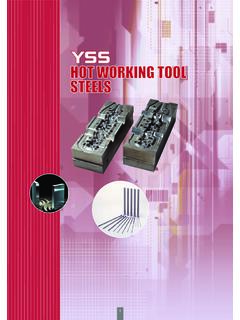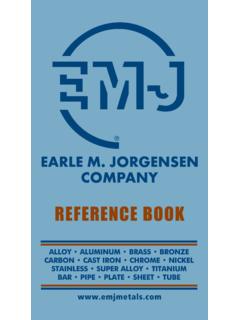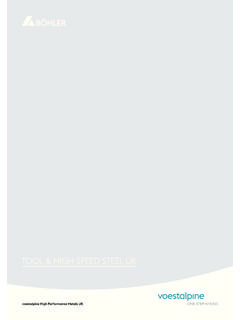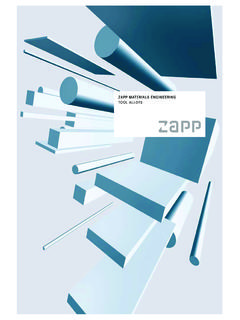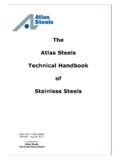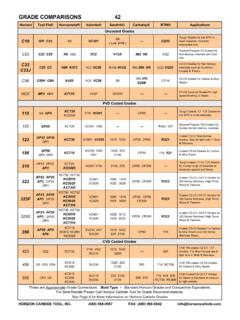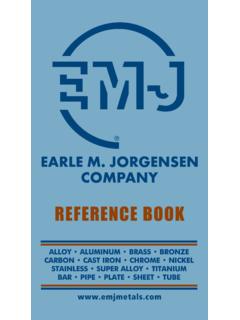Transcription of Standard Specification for Tool Steels Alloy1
1 Designation: A 681 08 Standard Specification forTool Steels Alloy1 This Standard is issued under the fixed designation A 681; the number immediately following the designation indicates the year oforiginal adoption or, in the case of revision, the year of last revision. A number in parentheses indicates the year of last reapproval. Asuperscript epsilon ( ) indicates an editorial change since the last revision or Standard has been approved for use by agencies of the Department of This specification covers the chemical, mechanical, andphysical requirements for available wrought alloy tool These products, which include hot or cold finished bar,plate, sheet, strip, rod, wire, or forgings, are normally fabri-cated into tools, dies, or fixtures.
2 The selection of a material fora particular application will depend upon design, serviceconditions, and desired The values stated in inch-pound units are to be regardedas Standard . The values given in parentheses are mathematicalconversions to SI units that are provided for information onlyand are not considered Referenced standards :2A 370 Test Methods and Definitions for Mechanical Testingof steel ProductsA 561 Practice for Macroetch Testing of tool steel BarsA 600 Specification for tool steel High SpeedA 700 Practices for Packaging, Marking, and LoadingMethods for steel Products for ShipmentE3 Guide for Preparation of Metallographic SpecimensE30 Test Methods for Chemical Analysis of steel , CastIron, Open-Hearth Iron, and Wrought Iron3E45 Test Methods for Determining the Inclusion Contentof SteelE59 Practice for Sampling steel and Iron for Determinationof Chemical Composition3E 527 Practice for Numbering Metals and Alloys in theUnified Numbering System (UNS) Standard .
3 MIL-STD-163 steel Mill Products, Preparation for Ship-ment and standards :Fed. Std. No. 123 Marking and Shipment (Civil Agencies)4 Fed. Std. No. 183 Continuous Identification Marking ofIron and steel standards :SAE J1086 Recommended Practice for Numbering Metalsand Alloys (UNS)53. Material in accordance with this specification is classi-fied by chemical composition. Types correspond to respectiveAISI Work tool Steels , Identification Types H10 to H19 are characterized by a controlledchromium content along with other alloying elements. The firstfour, containing molybdenum, offer excellent toughness andhigh hardenability and are frequently used in cold workapplications requiring toughness at relatively high Types H21 to H26 are characterized by a controlledtungsten content along with other alloying elements.
4 Thesesteels offer greater resistance to the softening effect of elevatedservice temperatures but exhibit a lower degree of Types H41 to H43 are low-carbon modifications ofmolybdenum high speed tool Steels (Note 1) and have charac-teristics similar to the tungsten High-speed tool Steels are covered in SpecificationA Work tool Steels , Identification A Types A2 toA10 cover a wide range of carbon and alloy contents but allhave high hardenability and may be hardened in air. The lowcarbon Types A8 and A9 have less wear resistance but offergreater toughness than others in this group. Type A7, with highcarbon and vanadium, offers exceptional wear resistance but ata very low level of specification is under the jurisdiction of ASTM Committee A01 on steel ,Stainless steel and Related Alloys and is the direct responsibility of on tool edition approved Oct.
5 1, 2008. Published October 2008. Originallyapproved in 1973. Last previous edition approved in 2007 as A 681 07 referenced ASTM standards , visit the ASTM website, , orcontact ASTM Customer Service at ForAnnual Book of ASTMS tandardsvolume information, refer to the Standard s Document Summary page onthe ASTM The last approved version of this historical Standard is referencedon from the Standardization Documents, Order Desk, Bldg. 4, SectionD 700 Robbins Ave. Philadelphia, PA 19111-5094 Attn: from the Society of Automotive Engineers, 400 Commonwelth drive,Warrendale, PA ASTM International, 100 Barr Harbor Drive, PO Box C700, West Conshohocken, PA 19428-2959, United Work tool Steels , Identification D Types D2 toD7 are characterized by high carbon and high chromiumcontents and exhibit high resistance to abrasion.
6 The typescontaining molybdenum may be hardened in air and offer ahigh degree of dimensional stability in heat Work tool Steels , Identification O Types O1 toO7 are low-alloy types that must be hardened by quenching inoil. Sizes over about 2 in. (50 mm) in cross section usuallyexhibit lower interior Steels , Identification S Types S1 toS7 vary in alloy content but are intended for tool Steels , Identification L TypesL2 to L6 are low-alloy Steels with a wide range of carboncontent. The low-carbon types are generally used for structuralapplications requiring good levels of toughness, while thehigh-carbon types may be used for short-run tool Steels , Identification F TypesF1 to F2 are high-carbon Steels with varying tungsten contentused primarily for relatively short-run fine edge cutting Steels , Identification Types P2 to P6 are very low-carbon Steels and mustbe carburized after machining or Types P20 and P21 are usually supplied in theprehardened condition and can be placed in service directlyafter Ordering Orders for material under this specification shall includethe following information.
7 As required to describe adequatelythe desired Class of material (hot work tool steel , etc.), Type (H11, D2, etc.), Shape (sheet, strip, plate, flat bar, round bar, squarebar, hexagon bar, octagon, special shapes), Dimensions (thickness, width, diameter, length), Finish (hot rolled, forged, blasted or pickled, colddrawn, machined, ground, precision ground and polished), Condition (annealed, hardened and tempered, etc.), ASTM designation and year of issue, Special Materials and Unless otherwise specified, material covered by thisspecification shall be made by an electric melting process. Itshall be made from ingots or slabs that have been reduced incross section in such a manner and to such a degree as to ensureproper refinement of the solidification Chemical An analysis of each heat of steel shall be made by themanufacturer to determine the percentage of the elementsspecified, and these values shall conform to the requirementsfor chemical composition specified inTable 1.
8 If requested orrequired, the chemical composition shall be reported to thepurchaser or his Analysis may be made by the purchaser from finishedbars and forgings by machining off the entire cross section anddrilling parallel to the axis of the bar or forging at any pointmidway between the center and surface in accordance with thelatest issue of PracticeE59. The chemical analysis of thedrilling chips shall be made in accordance with the latest issueof Test MethodsE30. The chemical composition thus deter-mined shall not vary from the limits specified inTable RequirementsHardness Annealed hardness values shall be obtained in accor-dance with the latest issue of Test Methods and DefinitionsA 370, and shall not exceed the Brinell hardness values (orequivalent Rockwell hardness values) specified inTable Specimens for determination of minimum response tohardening shall be1 4-in.
9 ( ) thick disks cut so as torepresent either the full cross-sectional area or that midwaybetween the center and outer surface of the material. If thematerial form or size does not lend itself to accurate hardnessdetermination on1 4-in. thick cross-sectional disks, then longi-tudinal specimens may be used for hardness testing. Examplesare round bars less than1 2in. ( mm) in diameter or this case, the specimen shall be a minimum of 3 in. (76 mm)in length and parallel flats shall be ground on the original millsurfaces. The specimens shall be heat treated as prescribed inTable The hardness of the specimen after the specified heattreatment shall meet the minimum hardness value for theparticular type of steel shown inTable 3.
10 Rockwell C testsshould be used where possible but light load tests may benecessary on thin specimens. These tests should be specified byagreement between the seller and the purchaser. The hardnessvalue shall be obtained in accordance with the latest issue ofTest Methods and DefinitionsA 370, and shall be the averageof at least five readings taken in an area midway between thecenter and surface of the largest dimension of the cross-sectional specimen or along the parallel surfaces of thelongitudinal Specimens for the determination of the macrostructureshall represent the entire cross-sectional area in the annealedcondition and be prepared in accordance with the latest issue ofPracticeA 561.
